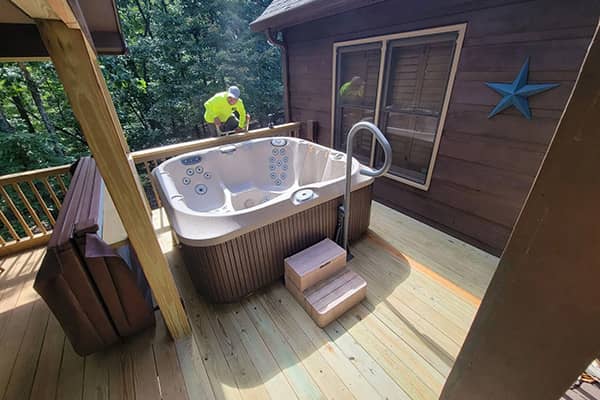Creating a Relaxing and Functional Outdoor Oasis with a Deck-Integrated Hot Tub
Adding a hot tub to your deck can transform your outdoor space into a luxurious retreat where you can relax and unwind. However, integrating a hot tub into your deck design requires careful planning and consideration to ensure it’s both safe and aesthetically pleasing. Here’s what you need to know when incorporating a hot tub on your deck.

1. Structural Integrity and Load-Bearing Capacity
The first and most critical consideration is ensuring your deck can safely support the weight of the hot tub. Hot tubs are heavy, and when filled with water and people, their weight can increase significantly.
- Load-Bearing Requirements:
- Weight Consideration: A hot tub can weigh between 3,000 and 6,000 pounds when filled with water and occupants. It’s essential to calculate the total weight and ensure your deck’s load-bearing capacity can handle it.
- Reinforcement: Depending on your deck’s existing structure, you may need to reinforce the joists, add additional support beams, or pour new footings to accommodate the extra weight.
- Professional Assessment: Consult a structural engineer or a professional deck builder to assess your deck’s ability to support a hot tub. They can provide recommendations for any necessary reinforcements.
2. Placement and Accessibility
Choosing the right location for your hot tub on the deck is essential for both functionality and enjoyment. Consider how the hot tub will fit into your overall deck layout and how easily it can be accessed.
- Location:
- Privacy: Position the hot tub in a location that offers privacy from neighbors and street views. Consider using privacy screens, pergolas, or strategic landscaping to create a secluded oasis.
- Proximity to the House: Placing the hot tub near an entry to your home allows for easy access, especially during colder months. However, ensure there’s enough clearance from windows and doors to prevent moisture damage.
- View: If possible, position the hot tub to take advantage of scenic views, whether it’s a garden, mountains, or a waterfront.
- Accessibility:
- Steps and Handrails: Incorporate steps and handrails to make it easy and safe to get in and out of the hot tub. Non-slip materials for the steps are recommended to prevent accidents.
- Pathways: Ensure there are clear, well-lit pathways leading to the hot tub, especially if it’s placed at a distance from the house.
3. Electrical and Plumbing Considerations
Installing a hot tub on your deck requires proper electrical and plumbing connections to ensure safe and efficient operation.
- Electrical Requirements:
- Power Source: Most hot tubs require a dedicated electrical circuit with a GFCI (Ground Fault Circuit Interrupter) breaker to prevent electrical shocks. Ensure your home’s electrical system can accommodate the additional load.
- Professional Installation: Electrical connections should be made by a licensed electrician to comply with local codes and ensure safety.
- Plumbing Considerations:
- Water Source: Ensure there’s easy access to a water source for filling the hot tub. You may also want to consider installing a hose bib or outdoor faucet nearby.
- Drainage: Plan for proper drainage of the hot tub, including overflow and regular maintenance draining. Ensure water can be safely directed away from the deck and foundation to prevent damage.
4. Design Integration
Your hot tub should seamlessly blend with the overall design of your deck and outdoor space. Thoughtful design integration will make the hot tub a natural and visually appealing feature.
- Decking Material:
- Complementary Materials: Choose decking materials that complement the hot tub’s exterior. For instance, composite decking pairs well with modern hot tubs, while natural wood can enhance a rustic look.
- Heat and Moisture Resistance: Select materials that are resistant to heat and moisture, as these elements will be more prevalent around the hot tub.
- Surrounding Features:
- Built-In Seating: Incorporate built-in seating around the hot tub to create a social area for those not in the water. Benches or lounge chairs can provide comfortable spots for relaxing and drying off.
- Planters and Greenery: Surround the hot tub with planters or greenery to enhance the aesthetic appeal and create a serene environment.
- Lighting: Add ambient lighting around the hot tub area to create a soothing atmosphere for evening use. LED strip lights, path lights, or overhead string lights can all enhance the mood.
5. Safety and Maintenance
Maintaining safety and ease of use is crucial when adding a hot tub to your deck.
- Safety Features:
- Covers and Locks: Use a hot tub cover with a locking mechanism to prevent accidents when the tub is not in use. This is especially important if you have children or pets.
- Non-Slip Surfaces: Ensure all surfaces around the hot tub are non-slip to prevent falls. This includes the deck itself, steps, and any nearby walkways.
- Maintenance Access:
- Service Panels: Make sure the hot tub’s service panels are easily accessible for maintenance and repairs.
- Cleaning: Plan for regular cleaning and maintenance of the hot tub and surrounding deck area to keep everything in top condition.
Conclusion
Incorporating a hot tub into your deck design is a fantastic way to enhance your outdoor living space, offering both relaxation and entertainment opportunities. By carefully considering structural integrity, placement, electrical and plumbing needs, and design integration, you can create a stunning and functional area that will serve as a personal retreat for years to come.
At North Georgia Elite Decks, we specialize in designing and building custom decks that perfectly accommodate features like hot tubs. Contact us today to start planning your dream deck with a luxurious hot tub, ensuring every detail is crafted to your needs and lifestyle.

